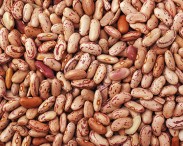All About Growing Dry Beans

Dry beans and peas provide as much protein per serving as well-known protein powerhouses, such as eggs and cottage cheese, with the added benefits of fiber and an array of minerals. You could eat the dry seeds from any green bean or pea, but certain bean and pea varieties grown for their higher yields of flavorful, nutrient-dense seeds are a better use of garden space. When growing dry beans and peas in most climates, plant after your spring crops so they mature in dry fall weather. Legume flowers attract beneficial insects, and because of legume plants’ ability to obtain much of their nitrogen through partnerships with soil-dwelling bacteria, beans and peas remove fewer nutrients from the soil compared with most other crops.
Types of Dry Beans and Peas to Try
Choosing varieties that suit your climate is key to growing dry beans and peas. Note that all dry bean and pea varieties can be harvested and cooked fresh as the seeds approach ripeness, or you can leave them to mature into their dry, easy-to-store form.
Soup peas (Pisum sativum) are a cool-weather crop cultivated like green shell peas, but starchy soup peas are smooth rather than wrinkled. These frost-tolerant peas should be planted quite early, in cool spring weather. Bush-type varieties, such as ‘Gold Harvest,’ form self-supporting blocks when grown in wide beds, but ‘Blue Pod Capucijners’ and other tall varieties will need a sturdy trellis. Soup peas grow best in cool northern climates, in slightly acidic to neutral soil with a pH from 5.5 to 7.0.
Traditional dry beans (Phaseolus vulgaris) look and grow like green snap beans, but the pods quickly become too tough and stringy to eat. Bush-type New England heirlooms, including ‘Kenearly Yellow Eye’ and ‘Jacob’s Cattle,’ tolerate cool soil conditions, so they are the best beans to grow where summers are short and cool. In warmer areas, bushy, black-and-white ‘Yin Yang’ (also known as ‘Calypso’) beans are as dependable as they are pretty. ‘Dwarf Horticultural’ beans can be sown after spring crops in areas with long summers. These and other true dry beans grow best in near-neutral soil with a pH between 6.5 and 7.0.
Many gardeners prefer to grow pole-type dry beans, which are grown up trellises or sown among knee-high sweet corn or sunflowers. Heirloom long-vined varieties — including intricately marked, brown-and-white ‘Hidatsa Shield’ and maroon-and-white ‘Good Mother Stallard’ — will eagerly scramble over drying corn in many climates. Where summer nights are warm and humid, ‘Turkey Craw’ and ‘Mayflower’ make outstanding cornfield beans provided they reach maturity in dry fall weather.
Article Source: Mother Earth News
